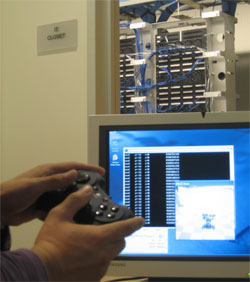OptIPuter Network Gives New Meaning to Remote Control
By Anna Lynn Spitzer
|
Irvine, Calif., 02.08.06 ─ How fast can you “drive” a car from Irvine to San Diego?
In a mere 50 milliseconds, if the car is UC Irvine’s remote-controlled “TMO Turtle” and the 90-mile trip is made over Calit2’s OptIPuter optical network.
A research project underway in Prof. Kane Kim’s UCI lab utilizes the OptIPuter connection between Irvine and UC San Diego to send commands that enable researchers at one campus to control the car, located at the other, in near real-time.
A researcher in Irvine uses a joystick that is connected to a computer on the OptIPuter network. With the joystick, he sends 30-40 commands per second to the car, located in San Diego. The car moves almost instantly, according to the commands it is receiving. A Webcam sends images back to Irvine at the rate of 30 frames per second, where a monitor allows the researcher to see the car and steer it in what feels like real-time – with the total delay of less than 100 milliseconds.
Global positioning systems built into servers at both campuses offer microsecond precision global time, allowing researchers to know precisely if their joystick commands are received on time.
Thanks to the power of the OptIPuter’s 1 gigabit-per-second optical connection and conservative message path management, the messages are transmitted with extremely low latency (lag time between the beginning of a request for data and the moment it begins to be received) and minimal jitter (variations in message communication delays).
|
||||
The software used to run the TMO (time-triggered, message-triggered object) demonstration was developed in Kim’s lab and is highly scalable, meaning it adapts well to increased demands. In order for the demonstration to succeed, two elements are essential, says Kim. “We need stable streaming of camera images, and we need reliable transmission of joystick commands over the OptIPuter to the local server, and over the wireless link from the local server to the car.
"If everything works according to plan, we will get minimal jitter and excellent responsiveness. We want the human driver with the joystick to feel as though the car is in the same room.”
|
The demo car has been constructed on an electric remote-control, racing-car chassis made in Germany. “TMO Turtle” is approximately 1/5 the size and scale of a real automobile, about 3 feet long. It contains three computers and a microcontroller, enabling researchers to control its speed and steering angle.
With the exception of the chassis, the car has been custom-designed using off-the-shelf components, including a body that is actually a plastic tote purchased from a container store. Two 12-volt lead and four 7.2-volt nickel-cadmium batteries supply the power.
The next step in the research is an attempt to control the car over a longer distance in similar “real-time” mode. Since the OptIPuter already maintains a 10-Gb connection from San Diego to Chicago, Ill., a distance of 2100 miles, researchers hope to test-drive the car between the two cities as early as next fall.
The cutting-edge project is more than just high-tech video fun. “The car is a means for demonstrating the software technology,” says Kim. “The real goal is to establish and promote a new-generation, real-time programming and software engineering technology.
“This technology will lead to more economically developed, more reliable, and more easily expandable real-time computer applications than those currently available,” he says, citing video conferencing as an example. “When you’ve got a video conference with six or seven people in different cities involved, the existing technology doesn’t allow participants to talk and interact freely without experiencing frequent confusing situations.”
Future applications for TMO technology include remote control surgery, multi-media-based multi-party collaborations, defense or homeland security systems and collaboration between robots and autonomously navigating vehicles. “This is our first attempt at wider-area, real-time distributed computing,” says Kim. “There are endless future applications.”





